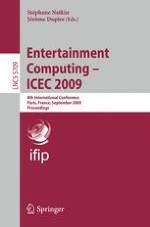This book constitutes the thoroughly refereed proceedings of the 8th International Conference on Entertainment Computing, ICEC 2009, held in Paris, France, in September 2009, under the auspices of IFIP.
The 14 revised long papers, 19 short papers and 23 poster papers and demos presented were carefully reviewed and selected from 105 submissions for inclusion in the book.
The papers cover all main domains of entertainment computing, from interactive music to games, taking a wide range of scientific domains from aesthetic to computer science.
